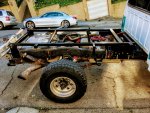I know the solid vs. spring vs. 3 point debate has been pretty well discussed.
I have a 1998 dodge 2500 long bed that I am wanting to put an aluminum flatbed on. The flatbed will be mounted with a
2011 Northern Lite that I will be modifying/improving (water damaged, so making it more what I want) There will be boxes mounted under the
flatbed for storage and boxes built onto the camper where the cutouts for a typical bed are. I am guessing I will be around 2200 - 2500 lbs for
the camper loaded on the flatbed.
On to the question. I have been leaning toward wanting to do a spring mount for the flatbed to eliminate some stress on the bed and camper.
I was thinking of fabricating mounts that would be welded to the flatbed and then bolt to the existing 6 mounting points that the stock bed fits on. One question is regarding whether to have spring mounts at all six locations or whether to hard mount the front or back two? My initial thought was to hard mount the front two and have
springs at the other four. I have been reading of people doing the opposite and solid mounting the back and spring mounting the front. I am not
an engineer, but it seems like the back of the frame would be more prone to movement. Anyone care to elaborate or explain? Another question is if the mounting to these 6 locations, do I need contact at the frame rails for support or would the 6 mounts be enough? I understand I need to have bracing at the mounts to stop side to side movement and forward to back. I would also be interested in any suggestions for springs to use based on the above mentioned weight?
Can anyone share an example of a 2500 or 3500 with a spring mount? I have asked around my region quite a bit but haven't found anyone with the confidence to help with this. I have some welders and fabricators that can help, but I will need to decide on the design. Any other suggestions or things to take into consideration? It's a used flatbed I have already purchased, so if pictures of the underside of the flatbed or the truck mounts would help I can take them and post.
Once I get this part figured out I will start a build thread on the project. i have really appreciated everyone's sharing and knowledge on the site and hope to give a little back on the camper build. I have rebuilt a few campers at this point, but the spring mount is new territory.
Thanks for any help!
I have a 1998 dodge 2500 long bed that I am wanting to put an aluminum flatbed on. The flatbed will be mounted with a
2011 Northern Lite that I will be modifying/improving (water damaged, so making it more what I want) There will be boxes mounted under the
flatbed for storage and boxes built onto the camper where the cutouts for a typical bed are. I am guessing I will be around 2200 - 2500 lbs for
the camper loaded on the flatbed.
On to the question. I have been leaning toward wanting to do a spring mount for the flatbed to eliminate some stress on the bed and camper.
I was thinking of fabricating mounts that would be welded to the flatbed and then bolt to the existing 6 mounting points that the stock bed fits on. One question is regarding whether to have spring mounts at all six locations or whether to hard mount the front or back two? My initial thought was to hard mount the front two and have
springs at the other four. I have been reading of people doing the opposite and solid mounting the back and spring mounting the front. I am not
an engineer, but it seems like the back of the frame would be more prone to movement. Anyone care to elaborate or explain? Another question is if the mounting to these 6 locations, do I need contact at the frame rails for support or would the 6 mounts be enough? I understand I need to have bracing at the mounts to stop side to side movement and forward to back. I would also be interested in any suggestions for springs to use based on the above mentioned weight?
Can anyone share an example of a 2500 or 3500 with a spring mount? I have asked around my region quite a bit but haven't found anyone with the confidence to help with this. I have some welders and fabricators that can help, but I will need to decide on the design. Any other suggestions or things to take into consideration? It's a used flatbed I have already purchased, so if pictures of the underside of the flatbed or the truck mounts would help I can take them and post.
Once I get this part figured out I will start a build thread on the project. i have really appreciated everyone's sharing and knowledge on the site and hope to give a little back on the camper build. I have rebuilt a few campers at this point, but the spring mount is new territory.
Thanks for any help!








